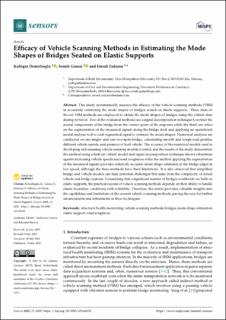| dc.contributor.author | Demirlioglu, Kültigin | |
| dc.contributor.author | Gonen, Semih | |
| dc.contributor.author | Erduran, Emrah | |
| dc.date.accessioned | 2023-11-23T07:27:42Z | |
| dc.date.available | 2023-11-23T07:27:42Z | |
| dc.date.created | 2023-09-26T10:43:17Z | |
| dc.date.issued | 2023 | |
| dc.identifier.citation | Sensors. 2023, 23 (14), . | en_US |
| dc.identifier.issn | 1424-8220 | |
| dc.identifier.uri | https://hdl.handle.net/11250/3104215 | |
| dc.description.abstract | This study systematically assesses the efficacy of the vehicle scanning methods (VSM) in accurately estimating the mode shapes of bridges seated on elastic supports. Three state-ofthe-art VSM methods are employed to obtain the mode shapes of bridges using the vehicle data during its travel. Two of the evaluated methods use a signal decomposition technique to extract the modal components of the bridge from the contact point of the response while the third one relies on the segmentation of the measured signals along the bridge deck and applying an operational modal analysis tool to each segmented signal to estimate the mode shapes. Numerical analyses are conducted on one single- and one two-span bridge, considering smooth and rough road profiles, different vehicle speeds, and presence of lead vehicle. The accuracy of the numerical models used in developing and assessing vehicle scanning models is tested, and the results of the study demonstrate the method using a half-car vehicle model and signal decomposition technique shows robustness against increasing vehicle speeds and road roughness while the method applying the segmentation of the measured signals provides relatively accurate mode shape estimates at the bridge edges at low speed, although the three methods have their limitations. It is also observed that simplified bridge and vehicle models can hide potential challenges that arise from the complexity of actual vehicle and bridge systems. Considering that a significant number of bridges worldwide are built on elastic supports, the practical success of vehicle scanning methods depends on their ability to handle elastic boundary conditions with reliability. Therefore, the article provides valuable insights into the capabilities and limitations of the current vehicle scanning methods, paving the way for further advancements and refinements in these techniques. | en_US |
| dc.language.iso | eng | en_US |
| dc.rights | Navngivelse 4.0 Internasjonal | * |
| dc.rights.uri | http://creativecommons.org/licenses/by/4.0/deed.no | * |
| dc.title | Efficacy of Vehicle Scanning Methods in Estimating the Mode Shapes of Bridges Seated on Elastic Supports | en_US |
| dc.type | Peer reviewed | en_US |
| dc.type | Journal article | en_US |
| dc.description.version | publishedVersion | en_US |
| cristin.ispublished | true | |
| cristin.fulltext | original | |
| cristin.qualitycode | 1 | |
| dc.identifier.doi | 10.3390/s23146335 | |
| dc.identifier.cristin | 2178888 | |
| dc.source.journal | Sensors | en_US |
| dc.source.volume | 23 | en_US |
| dc.source.issue | 14 | en_US |
| dc.source.pagenumber | 25 | en_US |

